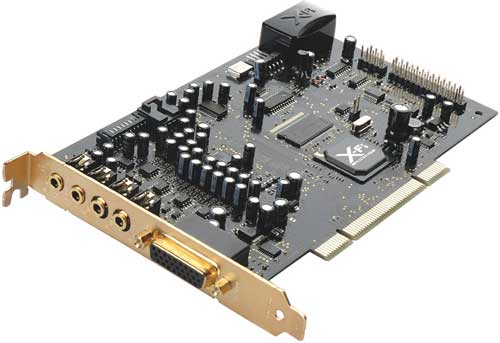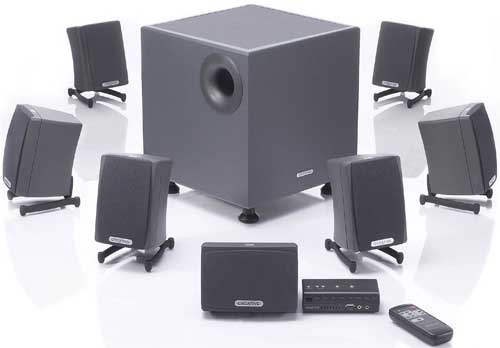The Business of Technology: Creative Labs
by Ryan Smith on October 2, 2007 5:00 PM EST- Posted in
- Bulldozer
Creative's Technology
So what has brought upon these changes in revenue and Creative's overall business problems? The answer to that lies in what's been going on with their technology and individual product market share.
Earlier we called Creative the king of sound cards until recently, much of their business woes stems from that loss. Creative's history is one founded on the back of the Sound Blaster hardware and the Sound Blaster name, creating a problem for Creative in having all of their eggs in one basket that they have been trying to solve for years. All told, Creative hasn't had a lot of luck spreading out their business and doing well; various efforts like graphics cards and DVD-ROM drives never panned out. Of the few things that have panned out, Creative's major consumer product lines have settled in as the following: portable media players, sound cards, webcams, and speakers.
Since sound cards were Creative's biggest business at one point, it has been Creative's biggest loss. Onboard audio has gone from a joke 10 years ago to how the vast majority of computers today handle audio, and it has been Creative who has suffered the greatest losses from that. The Live and Audigy series have both been bonafide successes in terms of sales, but never the less sales are slowing and the X-Fi likely won't be nearly as successful. The fact of the matter is that the consumer sound card market is on its last leg and the possible user base for such hardware has shrunk to professionals and gamers, and that's it.

The X-Fi will likely be the last significant feature-heavy sound DSP to be released by anyone, and it will never match the kinds of sales Creative has seen with earlier products. The final nail in the coffin will be Windows Vista, which as we have discussed in our review of that operating system, under normal circumstances runs the entire audio subsystem in software, reducing the need for a sound card down to a DAC to handle the digital/analog conversion. Creative's own troubles in writing solid Vista drivers for their sound cards hasn't helped matters either, but this has only hastened the inevitable. The sound card is dead, and it isn't coming back.
So what is Creative's leading product with the demise of the sound card? As we saw in their financials, it's now portable media players, a growing market but unfortunately for Creative it's one that they're getting slaughtered in. Prior to the arrival of the iPod, Creative was vying for the top of the portable media player market next to the now-defunct Rio brand, leading to the infamous Slashdot quote about the iPod's release: "No wireless. Less space than a nomad. Lame." Now Creative is struggling in a market where it was one of the first players.

Apple has the vast majority of the North American market for obvious reasons, but #2 tends to be shocking to most people: SanDisk. With Apple's main focus on the mid-to-high end MP3 player market, it has left an opening for cheap media players that SanDisk has been able to fill. Meanwhile both SanDisk and Apple have kept Creative and the other competitors locked out of the market, with Creative taking the #3 spot with less than 4% of the market. Creative's problems are further compounded by Microsoft at #4, who is more than happy to lose money on the media player market for now, and previously backed the PlaysForSure technology that Creative uses for DRM. It should be noted however that Apple doesn't have this kind of penetration in Asia, but as there are no reliable statistics on sales in most Asian markets, we can't ascertain what Creative's exact share there is, but it's believed to still be well below #1.
As a result of all of this, what little share of the market Creative has is almost entirely composed of the near-commodity market, save the small number of "anything but Apple" sales. Their Nomad and Zen lines do not have any significant brand recognition, meanwhile SanDisk can build & sell flash based media players for less than Creative. What little bit of the near-commodity market Creative does have a strong foot in is hard drive based media players that focus on video, and even this is at risk of being undermined by Apple now that they have a full-screen iPod to compete. In spite of all of this the majority of Creative's revenue comes from portable media player sales, but fighting on the near-commodity market means they will never be able to attain much of a profit with it.
Creative's third market segment, webcams, is more or less the same story. Webcams are a commodity - there's a lot of competition and not a lot of money. They may stay in it, but they'll never be able to repeat their most profitable days relying on webcams.
There is one bright spot for Creative however, and that's speakers. In their efforts to branch out Creative picked up Cambridge Soundworks in 1997, and their speaker division has continued to perform well. Creative is only dealing in computer speakers which limits their overall market and they face stiff competition from the likes of Logitech, but this market isn't quite a commodity market like Creative's other major markets. In fact as a percentage of revenue the speaker division is nearly 20%, which is itself nearly twice as much as it was 2 years ago. We'd expect Creative to be pushing their speaker products harder as the sound card market finishes crashing, since even with the integration of audio consumers still need speakers.

Finally there are all of Creative's other markets, which we'll touch on briefly. Creative continues to sell various peripherals, such as mice and routers, but most of these are low-volume products that are simply rebranded products form other suppliers. In fact most readers have probably never seen these products in a local store; Creative's minor product lines are almost exclusively limited to the Asian markets. The profitability from these operations is reportedly decent, but it's not something that Creative can win at in the international markets.










95 Comments
View All Comments
BitJunkie - Wednesday, October 3, 2007 - link
Great article, and good summary. Could list at least 10 reasons to be annoyed with Creative but the most illustrative is that:You can't plug an AC'97 based front connector in to their X-Fi add-in boards. So EVEN IF someone wanted to use one of their boards rather than the excellent Realtek integrated solutions you automatically gimp the functionality of your chassis unless you buy their intel based front panel and clog up a 3" drive bay. They are using standards to force people to buy their own products. I paid for an add-in board, discovered this and threw the thing away. That's the last cent they get from me.
RIP Creative.
The Jedi - Saturday, October 6, 2007 - link
It turns out Intel is the one who changed up the front audio panel header from the AC'97 standard to the HD Audio standard. Creative supports the newer HD Audio front ports, but most PC cases have the older AC'97 ports. I've run into this myself and it looks like I only get headphones in the front. It looks like Auzentech actually supports the AC'97 standard ports on their cards FWIW.BitJunkie - Sunday, October 7, 2007 - link
That's my point. Creative resist the HD Audio standard when it comes to the implementation of their add-in cards, but rather cynically use it for their front panel connector. So for the majority of people who have an AC'97 front panels built in to their chassis, they are forced to buy the Creative front panel to have that front panel functionality.Guess what Creative do? they bundle the front panel with their more expensive add-in cards, forcing you to pay more than you want just to get some basic functionality you should have anyway. Idiots.
DaveLessnau - Wednesday, October 3, 2007 - link
I'd bump your rating up one, but it's already maxed out. This is EXACTLY why Creative's going bankrupt and everyone is glad its happening. Excellent post.bigpow - Tuesday, October 2, 2007 - link
I second that.It was all good and fun, while it lasted.
But it's time to move on and the end of an era is here.
IT industry don't have mercy for those who are slow or lame.
Only the fastest/most flexible ones can survive.
Compare that to the auto industry (if that's the case, the big 3 would be dead a long time ago)
n7 - Tuesday, October 2, 2007 - link
Nice summary.Good article too, thanx.
trelin - Tuesday, October 2, 2007 - link
I've always kept a spot of sincere hatred for Creative for the way they sued Aureal into declaring bankruptcy, then purchasing the Aureal IP afterwards.Aureal eventually won the lawsuit, but legal defense costs tied up funding for the AU8830. By the time it was done they simply did not have the funds to bulk produce the virtually completed chip/reference-card design and had to scrap the project.
I don't begrudge Creative for making an inferior product, but for their deplorable tactics I do hope they die and are forced sell their IP for a fraction of their development costs.
takumsawsherman - Wednesday, October 3, 2007 - link
Yes, this was total manipulation of the legal system by Creative for illicit destruction of a competitor. Having always used Sound Blaster cards for add-in situations, I was skeptical when my distributor sales guy told me to try some Aureal Vortex 2 SuperQuads. But, seeing as the Creative equivalent was $100 at the time, and the Superquads were $50 retail, I figured I would give them a shot.The sound quality was amazing, and while the drivers weren't perfect, this was the beginning of Creatives "horrible overstuffed driver" stage. $50 got the machine amazing 3D sound with A3D which Creative tried to "me too" with EAX. Except that A3D was really great, and EAX sounded like garbage. I was a convert, and was able to cheaply add great sound to the systems I was building.
Unfortunately, instead of rising to the challenge, Creative used it's tried and true "sue them into submission" strategy. Years later, I come across many SB cards with horrible crackling noises, pain in the butt driver installs, and my brain has me convinced that those old SuperQuads still sound better. Aureal was a fantastic company with fantastic technology, and Creative's big bankroll was the only thing that enabled them to drain Aureal's.
So, I totally agree with your last sentence, except I will add that I hope the Aureal people raise money to buy the IP and then make the moves that will revitalize the market.
sc3252 - Tuesday, October 2, 2007 - link
"Creative's problems are further compounded by Microsoft at #4, who is more than happy to lose money on the media player market for now" Golden! Microsoft seems to love losing money, as long as they have a chance next round.ricleo2 - Tuesday, October 2, 2007 - link
Another great article here on Anandtech. This is one of the few articles here I fully understand. When I company in this shape starts spending more on R and D, look for a rebound. Otherwise look for bankruptcy or a buyout.